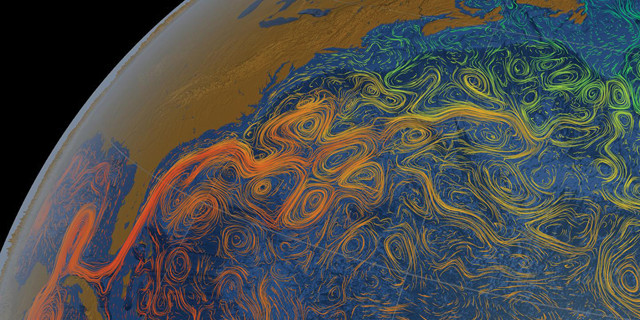
by Rachel Crowell Tuesday, October 16, 2018

New research shows that counterclockwise-rotating cold eddies are transporting iron from the Gulf Stream into the North Atlantic subtropical gyre. Credit: NASA Goddard Space Flight Center Scientific Visualization Studio.
Dust from the Sahara Desert is a major supplier of iron to the North Atlantic subtropical gyre — the huge circular ocean current stretching between North America and the west coasts of Africa and Europe — where cyanobacteria use the scarce nutrient to fuel nitrogen fixation, which then fertilizes other organisms at the base of the marine food chain. Now, researchers have discovered that eddies spinning off the Gulf Stream also transport iron to the northwestern edge of the gyre.
Iron content can be challenging to measure because samples are easily contaminated with metal from instrumentation and other sources, says Jaime Palter, a physical oceanographer at the University of Rhode Island and co-author of a new study in Nature Geoscience. With few experts available who are trained in clean iron sampling techniques, “every measurement [of oceanic iron content] is considered very valuable,” she notes.
Scientists already knew that eddies swirling off the Gulf Stream transport phosphorus to the subtropical gyre. The discovery that such eddies also transport iron happened serendipitously when researchers examined previously published dissolved iron concentration data collected during a November 2011 oceanic research expedition from North America to Bermuda.
“The data was collected as part of a U.S. National Science Foundation-funded GEOTRACES expedition — an international program involving 35 countries, which is mapping the oceans for trace elements,” notes Timothy Conway, a chemical oceanographer at the University of South Florida and lead author of the study.
The team found evidence of a “cold core ring” — a type of “mesoscale” eddy that typically is less than 100 kilometers in diameter and rotates counterclockwise, forming a low-pressure system in the atmosphere above it that’s sustained over the several-year life cycle of the eddy. Within the otherwise iron-poor subtropical gyre, this ring contained iron-rich water originating from above the North American continental slope.
The team analyzed satellite altimetry data from 1993 to 2014. “Altimetry gives a measure of sea-surface height — and deformations of the sea surface are a very clear indicator of the presence of eddies,” Palter says. Their analysis revealed that approximately seven to eight cold core rings potentially capable of delivering iron to the subtropical gyre broke off the Gulf Stream each year. The finding, the team wrote, suggested that such rings could represent a significant source of iron to the North American subtropical gyre.
From there, the team looked at how the amount of iron transported to the subtropical gyre by cold core rings compares to that delivered via iron-rich dust from the Sahara, which was thought to be the leading source of iron for this area, Palter says.
The team estimated that the rings deliver about 15 percent as much iron to the area as atmospheric Saharan dust does, but the actual amount of iron delivered by the rings “could be much higher (or as low as a few percent),” Palter notes. To calculate the amount of iron delivered by the rings, the team first estimated the total iron flux to the gyre, based on the average number of rings, their average surface area and other considerations. “Then we accounted for rings that get re-absorbed by the Gulf Stream before sharing the iron with the gyre. Finally, we compared the result of this calculation against a compilation of atmospheric fluxes,” Palter says.
Although it appears for now that the eddies deliver less iron than dust does, she notes that there are still unanswered questions about the dust-delivered iron, such as how much of it dissolves in seawater and becomes bioavailable for phytoplankton to use. Eddy-delivered iron, meanwhile, is readily bioaccessible. Further study, she says, may reveal whether these eddies contribute an almost equal share, just a small fraction of the usable iron, or some amount in between.
Ocean eddies can carry iron and other materials over long distances and are known to be “leaky,” but the extent of this leakiness through an eddy’s lifetime is unknown, says Ivy Frenger, a biogeochemist at GEOMAR Helmholtz Center for Ocean Research Kiel in Germany, who wasn’t involved in the new study. Follow-up work is needed to determine if standard biogeochemical models of ocean mixing can adequately represent these transport processes or if updated models are needed, Frenger says.
“This is a very interesting study that highlights very well the importance of mesoscale ocean circulation — more specifically [cold core] rings — on primary productivity in the ocean,” says Carolina Dufour, a physical oceanographer at McGill University in Montreal who was not involved with this study. “Because iron is key to primary productivity, better understanding of the sources of iron to the ocean” could help researchers better predict the impacts of oceanic processes on Earth’s climate, Dufour says.
© 2008-2021. All rights reserved. Any copying, redistribution or retransmission of any of the contents of this service without the expressed written permission of the American Geosciences Institute is expressly prohibited. Click here for all copyright requests.